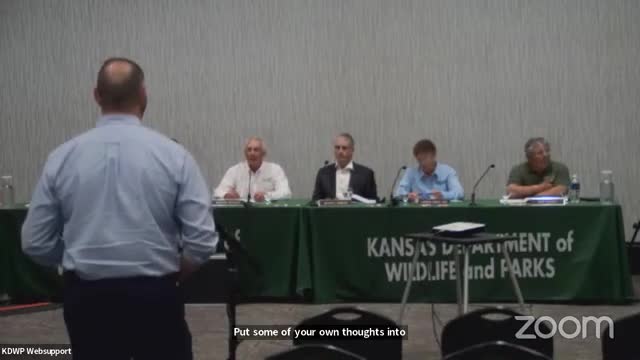Kansas hunters call for urgent deer management reforms
June 21, 2024 | Department of Wildlife & Parks, State Agencies, Organizations, Executive, Kansas

This article was created by AI summarizing key points discussed. AI makes mistakes, so for full details and context, please refer to the video of the full meeting. Please report any errors so we can fix them. Report an error »

During a recent government meeting, discussions centered on the management of deer populations and hunting regulations in Kansas, highlighting concerns over declining trophy deer numbers and the impact of technology on hunting practices.
One participant expressed a strong belief that trophy deer numbers are decreasing statewide, emphasizing the need to prioritize deer welfare over hunting advantages provided by technology such as cameras. This sentiment was echoed by others who underscored the importance of managing deer populations based on scientific data, particularly regarding the age structure of herds. The speaker shared a personal hunting experience that illustrated the challenges of identifying deer without adequate data, raising concerns about the potential negative impact on age structure when younger deer are mistakenly harvested.
Deputy Secretary Stuart Crogg acknowledged the lengthy process of implementing new regulations, which included extensive outreach efforts to gather public input. He noted that while the hunting season had recently concluded, the department is in the process of compiling data from field reports and public feedback to evaluate the effectiveness of current regulations. Preliminary reports indicated a decline in incidents of camera and SD card theft, suggesting a positive outcome from recent regulatory changes.
The meeting also featured public comments, including a proposal from Andrew Clark of Hays, Kansas, advocating for a lottery system for mule deer tags due to significant population declines in the region. Clark highlighted the drastic reduction in mule deer sightings since 2002, calling for measures to manage hunting pressure on public lands effectively. He urged attendees to communicate their support for proposed regulations to their legislators, emphasizing the importance of collective action in wildlife management.
Overall, the meeting underscored the ongoing challenges in wildlife management, the need for data-driven decision-making, and the importance of public engagement in shaping hunting regulations in Kansas.
One participant expressed a strong belief that trophy deer numbers are decreasing statewide, emphasizing the need to prioritize deer welfare over hunting advantages provided by technology such as cameras. This sentiment was echoed by others who underscored the importance of managing deer populations based on scientific data, particularly regarding the age structure of herds. The speaker shared a personal hunting experience that illustrated the challenges of identifying deer without adequate data, raising concerns about the potential negative impact on age structure when younger deer are mistakenly harvested.
Deputy Secretary Stuart Crogg acknowledged the lengthy process of implementing new regulations, which included extensive outreach efforts to gather public input. He noted that while the hunting season had recently concluded, the department is in the process of compiling data from field reports and public feedback to evaluate the effectiveness of current regulations. Preliminary reports indicated a decline in incidents of camera and SD card theft, suggesting a positive outcome from recent regulatory changes.
The meeting also featured public comments, including a proposal from Andrew Clark of Hays, Kansas, advocating for a lottery system for mule deer tags due to significant population declines in the region. Clark highlighted the drastic reduction in mule deer sightings since 2002, calling for measures to manage hunting pressure on public lands effectively. He urged attendees to communicate their support for proposed regulations to their legislators, emphasizing the importance of collective action in wildlife management.
Overall, the meeting underscored the ongoing challenges in wildlife management, the need for data-driven decision-making, and the importance of public engagement in shaping hunting regulations in Kansas.
View full meeting
This article is based on a recent meeting—watch the full video and explore the complete transcript for deeper insights into the discussion.
View full meeting
